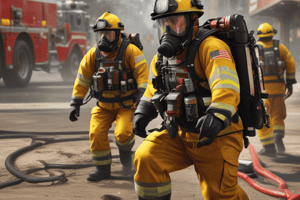Podcast
Questions and Answers
What are the three hazardous materials operational zones according to the document?
What are the three hazardous materials operational zones according to the document?
- The clean zone, the dirty zone, and the decontamination zone
- The exclusion zone, the contamination reduction zone, and the support zone (correct)
- The evacuation zone, the quarantine zone, and the treatment zone
- The cold zone, the hot zone, and the warm zone
What should the first arriving unit do when approaching the scene of a hazardous materials incident?
What should the first arriving unit do when approaching the scene of a hazardous materials incident?
- Approach from upwind and uphill (correct)
- Approach from the side with the most visible damage
- Approach from downwind and downhill
- Approach from the side with the most bystanders
What should the incident commander do upon arrival at a hazardous materials incident?
What should the incident commander do upon arrival at a hazardous materials incident?
- Wait for additional resources to arrive before taking any action
- Evacuate the area immediately
- Identify the hazardous material(s) involved and perform a 360 assessment (correct)
- Begin mitigation activities immediately
What should be done after additional resources are requested at a hazardous materials incident?
What should be done after additional resources are requested at a hazardous materials incident?
Where should apparatus be positioned at a hazardous materials incident?
Where should apparatus be positioned at a hazardous materials incident?
What are the primary objectives of a hazardous materials response?
What are the primary objectives of a hazardous materials response?
What should be the limit of hazardous materials mitigation activities?
What should be the limit of hazardous materials mitigation activities?
How many hazardous material levels are there, and what is the highest level?
How many hazardous material levels are there, and what is the highest level?
What is the purpose of the contamination reduction zone in a hazardous materials incident?
What is the purpose of the contamination reduction zone in a hazardous materials incident?
Flashcards are hidden until you start studying
Study Notes
- The document provides procedures for Chesapeake Fire Department units responding to incidents involving hazardous materials.
- The three hazardous materials operational zones are the exclusion zone, contamination reduction zone, and support zone.
- The first arriving unit should approach the scene from upwind and uphill and stage in the cold zone.
- The incident commander should attempt to identify the hazardous material(s) involved and perform a 360 assessment.
- Additional resources should be requested, and an initial incident action plan should be developed.
- Apparatus should be positioned in the cold zone, and personnel should wear appropriate PPE.
- The primary objectives of a hazardous materials response include isolating, confining, and containing the hazardous material, evacuating the contaminated area, and denying entry to the contaminated area.
- Hazardous materials mitigation activities should not exceed the level of training and PPE required to contain and/or mitigate the hazard.
- Hazard levels are Level I, II, and III, with Level III incidents posing an extreme and immediate threat to the environment and/or public health.
- A procedure decision tree is provided.
Studying That Suits You
Use AI to generate personalized quizzes and flashcards to suit your learning preferences.




